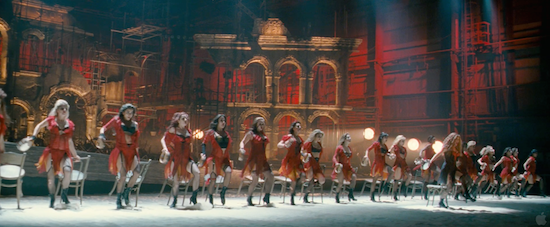Rob Marshall's Nine: The Problems With Shooting A Musical Like A (Bad) Music Video
What are the pleasures of musicals?
Musicals require from their performers the daunting task of simultaneously acting and singing, often while executing choreographed dance. That's a significant part of the reason we go pay to see live performances: to witness incredibly talented people perform these remarkable feats in real time. Musicals thrive on the tension between consummate professionalism and unpredictability. They also require the perception of continuity of motion in order to be fully enjoyed. When you fashion a musical into a film, you necessarily lose some of those elements.
But you don't have to lose all of them.
As an audience, we understand on some level that the audio is recorded separately, that the dances probably required dozens of takes to produce the final version that we see on screen. So we make a bargain with the filmmaker: We will try to forget these inexorable truths about the filmmaking process if you do your best replicate the magic of musicals using a screen, a projector, and a few speakers. Rob Marshall's Nine takes us up on this arrangement, only Marshall fails spectacularly at living up to his side of the bargain.
While it is a remake of Fellini's 8 ½, Nine is, at its core, a musical. And when the film has a shot that lasts longer than five seconds, it perfectly captures the pleasures of musicals. But for half of the film's dance numbers, the editing looks more like it came out of a caffeine-loaded college student's iMovie-edited experimental film. I desperately want to appreciate the intricacies of these musical numbers. I wanted to behold all of the dancers within a single frame, to watch them perform a series of impeccably timed moves in sequence. But the frantic editing and the baffling selection of shots denied me the opportunity to enjoy their talent.
As I struggled for something my eyes could hold onto in Nine, I was reminded of a famous quote from one of the greatest minds of our generation, "Beyonce had one of the best music videos of all time. OF ALL TIME!" Observe:
Beyonce's "Single Ladies" music video (inspired by the work of legendary choreographer Bob Fosse) is absolutely mesmerizing. The entire video is simply three dancers on a plain background with some great choreography, a bit of creative lighting, and only a handful of cuts. The frame is alive throughout, yet never distracts from the technical virtuosity of its subjects. I would say that, in comparison, Nine completely subsumes its talented performers in its pursuit of the cinematic, but that would imply that I thought Rob Marshall knew what he was trying to do with this film.
Still, Nine is not a complete wash. Penelope Cruz, Marion Cotillard and even Nicole Kidman each get musical numbers that are pretty effective (Unsurprisingly, they are mostly one-person numbers that don't require a myriad of dancers performing on screen). Cotillard, in particular, is radiant on screen and her numbers embody the best that musicals can be, songs that dazzle us aurally while conveying backstory, building character, and moving along the plot. I was also actually a fan of Marshall's splicing of dialogue and action into the musical numbers themselves. I'm not entirely sure it works, but it is always encouraging to see directors trying interesting methods at bringing this difficult art form to the big screen.
None of this takes away from the fact that the film, as a musical, is a mess. Most maddening of all is the film's centerpiece, a spectacularly choreographed number of the song "Be Italian" which employs the copious use of sand and tambourines. There's a reason you don't see sand very often in real-life musicals: despite the fact that it looks great, it's a bitch to clean up on a soundstage. Here, Rob Marshall had everything he needed to create a musical number for the ages: Boundless resources, formidable talent, and an impossibly large physical stage on which to set it.
And he completely squanders it.
Here is a question to consider: Why bother hiring dozens of dancers to perform an elaborately choreographed dance when the camera is often too close to see most of them? Over and over we're subjected to oblique angles and rapid cuts when what we really want to see is what the hell it is these women are doing. There is a way to film a musical dance number dynamically and still avoid giving your audience attention-deficit disorder. This is decidedly not it.
There's a shot towards the end of "Be Italian" during the song's recap where all of the performers are lined up, side-by-side, and advancing, deliberately and ominously, towards the camera. It's a stunning shot for a variety of reasons, but it captures the fundamental joy of watching a musical. A large group of people performing a dance in time to music (and the audience being able to see them all) can be absolutely breathtaking. Marshall would have done well to remember this more throughout the rest of his film.
Rob Marshall's Nine goes into limited release today, expanding wide on December 25, 2009.

